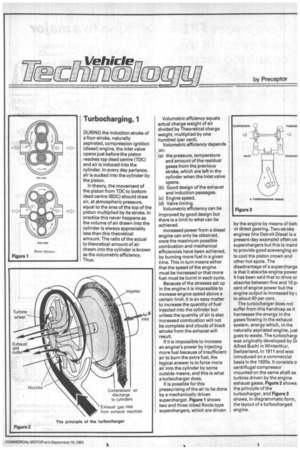Turbocharging, 1
Page 85

If you've noticed an error in this article please click here to report it so we can fix it.
DURING the induction stroke of a four-stroke, naturally aspirated, compression ignition (diesel) engine, the inlet valve opens just before the piston reaches top dead centre (TDC) and air is induced into the cylinder. In every day parlance, air is sucked into the cylinder by the piston.
In theory, the movement of the piston from TDC to bottom dead centre (BDC) should draw air, at atmospheric pressure, equal to the area of the top of the piston multiplied by its stroke. In practice this never happens as the volume of air drawn into the cylinder is always appreciably less than this theoretical amount. The ratio of the actual to theoretical amount of air drawn into the cylinder is known as the volumetric efficiency. Thus: Volumetric effciency equals actual charge weight of air divided by Theoretical charge weight, multiplied by one hundred (per cent). Volumetric efficiency depends on: ;(a) the pressure, temperature and amount of the residual gases from the previous stroke, which are left in the cylinder when the inlet valve opens.
(b) Good design of the exhaust and induction passages.
(c) Engine speed.
(d) Valve timing.
Volumetric efficiency can be improved by good design but there is a limit to what can be achieved, Increased power from a diesel engine can only be obtained, once the maximum possible combustion and mechanical efficiencies have been achieved, by burning more fuel in a given time. This in turn means either that the speed of the engine must be increased or that more fuel must be burnt in each cycle.
Because of the stresses set up in the engine it is impossible to increase engine speed above a certain limit. It is an easy matter to increase the quantity of fuel injected into the cylinder but unless the quantity of air is also increased combustion will not be complete and clouds of black smoke from the exhaust will result.
If it is impossible to increase an engine's power by injecting more fuel because of insufficient air to burn the extra fuel, the logical answer is to force more air into the cylinder by some outside means, and this is what a turbocharger does.
It is possible for this pressurising of the air to be done by a mechanically driven supercharger. Figure 1 shows two and three lobed Roots type superchargers, which are driven
by the engine by means of belt or direct gearing. Two-stroke engines the Detroit Diesel is a present-day example) often us superchargers but this is mainl to provide good scavenging an to cool the piston crown and other hot spots. The disadvantage of a supercharge is that it absorbs engine power It has been said that to drive or absorbs between five and 10 pi cent of engine power but the engine output is increased by L to about 40 per cent.
The turbocharger does not suffer from this handicap as it harnesses the energy in the gases flowing in the exhaust system, energy which, in the naturally aspirated engine, just goes to waste. The turbocharg, was originally developed by Dr Alfred Buchi in Winterthur, Switzerland, in 1911 and was introduced on a commercial basis in the 1920s. It consists ocentrifugal compressor mounted on the same shaft as turbine driven by the engine exhaust gases. Figure 2 shows the principle of the turbocharger, and Figure 3 shows, in diagrammatic form, the layout of a turbocharged engine.




























































































































